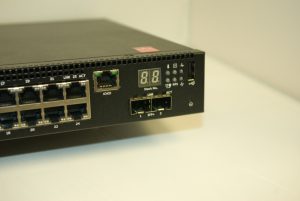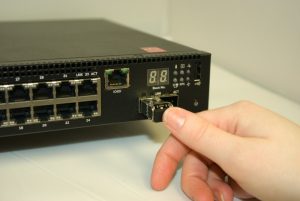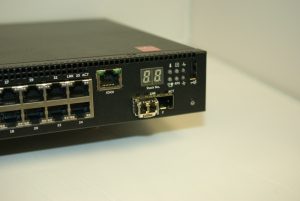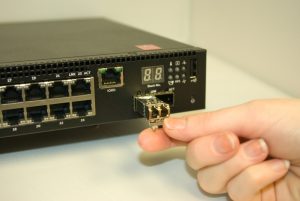Correctly installing and removing SFP modules is vital to ensuring the modules themselves and devices they are installed into, remain free from damage. SFP modules and their variants such as SFP+, QSFP+ etc are designed to be “hot-swappable” or “hot-pluggable”, meaning the switch, router, server or other device they are being installed into or removed from, doesn’t need to be powered down beforehand. Here follows a step by step guide to installing and removing modules correctly and safely.
Before we proceed any further, it is important to stress that you should never look directly into an optical module or into the core of any cable attached to a module that is installed and potentially “live” within it’s host device. Permanent eye damage, and even complete blindness can be caused. To check the operation of the module, refer to your device’s user guide for the correct method to check optical output.
Installing an SFP Module:
The first thing to note is the orientation of the module to the host device. You will notice the SFP port has a small clip breaking the metal work on one edge. This clip aligns with the exposed side of the PCB of the SFP module.

Take care as some devices that have 4 or more SFP ports often flip the bottom row of ports, so the SFP modules install in the opposite orientation. Providing you always align the clip with PCB side of the module you will not cause any damage to the SFP or internally within the port.

Once the correct orientation of the module is identified, place it into the port ensuring the dust cap is still in place and gently press it into position using your thumb. Press the module into position until it clicks into place and can’t be pressed in any further.

Once complete, the dust cap can be removed and the module is ready for operation.
Removing an SFP Module:
The process of removing an SFP module is quite simple and can be done when the host device is still powered on and live. This is useful for replacing older modules or upgrading them without taking whole sections of a network offline.

SFP modules that have a “bale clasp” – the small coloured plastic tube that sits above the LC connector ports, are removed by first lowering the clasp. This unlatches the SFP module within the host device and enables it to be removed easily. Do not try to forcibly remove a module without first disengaging the latch with the bale clasp as this can cause damage to both the module and the port of the host device.

Once the clasp is completely pulled down the module will slightly move out of it’s port. From here on simply grasp the SFP module and pull it out in a straight forward motion.
Caring for SFP Modules:
It is important to remember SFP modules and their variants such as SFP+, QSFP+ etc are electrical devices and are sensitive to electrostatic discharge (ESD). Always ground yourself before handling electronic items with an ESD wrist strap, or at the very least discharge any static from your person by touching something that is grounded, such as a radiator pipe, before handling electronic items. Also remember to place modules back into their packaging when not in use.
